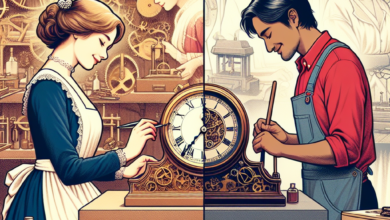A Parisian Love Under Siege: Tales of 1871
Part I: The City of Lights
Paris, the shimmering jewel of the 19th century, was a city pulsating with dreams and desires. The Seine wound through it like a silver ribbon, reflecting the golden glow of the gas lamps that flickered to life as dusk descended. In the spring of 1870, as the blooms of the cherry blossoms exploded in shades of pink and white, Émilie LaMotte found herself in the swirl of this enchanting season, her heart set aflame by a love that transcended the commonplace.
Émilie was a seamstress, her nimble fingers working tirelessly in a small atelier near the Place des Vosges. She had an eye for beauty, not only in the fabric she wielded but also in the fleeting moments of life. It was in this bustling courtyard that she first laid eyes on Julien, a painter with tousled hair and a gaze that seemed to capture the very essence of the city he adored. Their eyes met amidst the chatter of the market, and within that instant, a silent pact was formed—a bond stronger than any fabric that Émilie could sew.
As the days grew warmer, their meetings became a ritual. Émilie would sneak away during lunch to meet Julien at his favorite café, where the aroma of freshly baked baguettes mingled with the sweet scent of pastries. They would talk for hours, dreaming about the future, their laughter drifting into the Parisian air like fragments of forgotten songs.
However, the harmony of their romance was soon overshadowed by the storm clouds gathering on the horizon. Tensions were escalating between France and Prussia, whispers of war seeping into the cafés and salons, tainting conversations that once flowed freely about art and love. Soon, those whispers transformed into reality.
Part II: The Prelude to Siege
In July of 1870, the unthinkable happened—war was declared. Paris, with its streets soaked in passionate ideals and revolutionary fervor, was thrust into chaos. As troops prepared for combat, the hopes of a nation hung heavy in the air, charged with both fear and bravado. Julien, inspired by the plight of his fellow citizens, enlisted voluntarily, believing that art could not thrive amid despair.
“I must fight for the beauty of our land, Émilie,” he had declared with determination in his eyes, the sunlight catching the glint of fervor. “For what we love to exist, we must be willing to face the threats around us.”
Tears pooled in Émilie’s eyes as she clutched his hand. “And what of us, Julien? Your heart, your spirit… they are my world.”
“We will return to our dreams again,” he promised, pressing a tender kiss against her lips. But as the reality of war descended upon them, they both knew that each moment might be their last.
Part III: The Fall of Paris
The months dragged on, and Émilie’s heart grappled with a mixture of longing and dread. Paris thrummed with a restless energy, citizens banding together for communal efforts, preparing for the worst. News from the front grew grim. The once-vibrant banners of triumph began to fray at the edges, replaced by sorrow. Each telegram that arrived at Émilie’s door felt like a dagger, revealing losses that ripped through her heart with the ferocity of artillery fire.
By September, Paris had encircled itself under siege, the Prussian armies closing in like vultures. The city grew desolate as supplies dwindled, and rumblings of revolt began to rise. Émilie, her fingers stained with ink and thread, took refuge in her work, creating garments for those who still dared to dream of life beyond the barricades.
In the corners of her shop, she and her fellow seamstresses devised plans for the revolution. They stitched banners of resistance, their hopes woven into each meeting. The heart of Paris beat on, even as the conditions grew desperate.
On a cold October evening, as the winds howled through the narrow streets, Émilie found a familiar silhouette outside her shop. It was Julien, clothes tattered, dirt grimy on his cheeks, yet his spirit triumphant. He rushed inside, enveloping her in a fierce embrace.
“I live, Émilie! I have returned!” He let go of her to observe her face. “But the world—our world—has changed.”
“Can love endure this?” she asked softly, feeling a tingle race down her spine, hope intertwining with the relentless despair that surrounded them.
“We will make it endure,” Julien swore, determination settling in his voice like clay in a sculptor’s hands. “Together, we will create a new vision for Paris.”
Part IV: The Colors of Revolution
As Paris descended further into despair, the atmosphere shifted from mere survival to fervent rebellion. The spirit of the Commune ignited, a flame fueled by workers, artists, and students, bound by a collective dream of a better future. From the depths of their plight, a mosaic of revolutionary fervor emerged, vibrant and demanding.
Émilie and Julien found themselves swept up in the tide of change. Their days were spent patching wounds—both physical and spiritual. As they moved through the streets, they could see the colors of revolution come alive: red, white, and blue banners draped from every window, a symbol of defiance against the oppressor.
They volunteered in make-shift hospitals, their camaraderie deepening as they tended to the wounded, their hearts torn with every cry for help they could not immediately answer. The city they once adored was now rebuilded, literally and figuratively, amidst rioting and rebuilding, blood and hope intertwining beneath the crumbling facades.
The nights were filled with quiet conversations underwatered with fear, yet hopeful thoughts navigated their shared dreams. Under the flickering glow of candlelight, they planned for a future they envisioned beyond the siege—a Paris of artists and poets, where love was a universal currency, transcending the boundaries that tenuously held them apart.
Part V: The Collapse
But the siege grew stronger, and the days bled into one another. The malnourished citizens, driven to desperation, began to fracture. As the commune tried to salvage its existence, the Prussian forces lined the periphery, watching, waiting.
On a chilling April morning, gunfire erupted nearby. Émilie stood in her atelier, the sound echoing in her ears. Julien burst through the door, pale-faced and trembling.
“The barricades are falling!” he gasped. “They are stronger than we anticipated. We must stand our ground, Émilie!”
“I can’t bear to lose you again,” she breathed, trepidation coloring her voice.
“We cannot allow ourselves to be defeated!” he shouted, a spark of passion igniting his eyes.
With that, they rushed to the streets, joining others as they rallied in defiance. The cobblestones beneath their feet held echoes of revolution, hope rising and drowning with every shot fired. Émilie and Julien fought side by side for a cause larger than themselves—together, they were a brushstroke upon the vast canvas of history.
But as the week wore on, the barricades succumbed to relentless assaults. Three days later, combat surged, loud and terrible—a cacophony of doubt. Within moments, all semblance of freedom they fought for hung by a thread, until a bullet pierced through the air, striking Julien.
Time froze as she rushed to him, cradling his head in her lap. “Julien! Stay with me, please!” she begged, tears springing from her eyes.
His breath caught, the fire in his gaze dimming. “Émilie,” he whispered, “promise… paint our love… for the world to see.”
With those final words, Julien succumbed, and a piece of her heart shattered into oblivion. The sound of chaos faded into a haunting silence as Émilie held onto him, clutching tight as Paris crumbled around them.
Part VI: A New Dawn
The fall of the Commune marked a significant moment in Parisian history. They were defeated, yet within that defeat lay the seeds of hope. Émilie, determined to honor Julien’s final wish, took to her sewing machine again. Each stitch became a channel for her grief and love, each thread woven with the memory of a city’s longing for freedom.
Months turned into years, and Émilie transformed her heartbreaking loss into a gallery of expression. Paris would not be defined by its siege, nor would its people exist in darkness. Through her art, she chronicled their struggle, weaving together the tales of love and loss, resilience and hope.
As the city seemed to awaken once more, amid the desolation of war, Émilie held the memories of her love tightly, painting the legacy of Julien into every corner of her vibrant future. She would fight to remind the world that love was not a casualty of war, and in that struggle, she found the strength to carry it forward.
Paris endured; love endured.
Epilogue
Much later, as Émilie stood before a canvas—the fabrics of her past stitched together in a tale of tenacity—she felt Julien’s spirit beside her. His laughter mingled with the whispers of the wind, encouraging her to love fiercely, with abandon. The heart of Paris thumped beneath the layers of time, and she knew that, together, they would always shine brightly, even in the shadows of a world touched by siege.




